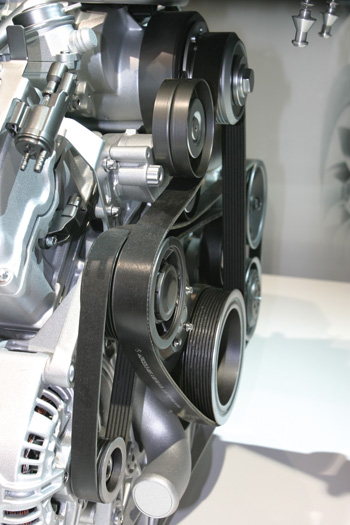 Serpentine belts, V-belts and timing belts are all automotive components that have a limited service life. New belts should always be recommended when a customer is buying a water pump, alternator, A/C compressor or power steering pump. A new timing belt should also be installed when replacing a cylinder head or camshaft on an overhead cam (OHC) engine with a belt cam drive.
Serpentine belts, V-belts and timing belts are all automotive components that have a limited service life. New belts should always be recommended when a customer is buying a water pump, alternator, A/C compressor or power steering pump. A new timing belt should also be installed when replacing a cylinder head or camshaft on an overhead cam (OHC) engine with a belt cam drive.
Most new car warranties will cover the timing belt for the specified period (if it breaks), but usually exclude any other drive belts because they are considered wear items.
Vehicle manufacturer recommended replacement intervals for timing belts vary, but are typically 60,000 miles for older (1990s and earlier) OHC engine applications, and up to 100,000 miles or more for newer models. But for serpentine belts, there are usually no replacement recommendations. They may suggest inspecting the belt at every oil change, once a year or every 30,000 to 50,000 miles. The need for belt replacement is usually based on the belt’s condition.
Many consumers have no idea how to inspect the belts on their vehicles or how to determine if they need a new belt. Obviously, if a belt has snapped, it’s history, and your customer needs a new one. A belt that is frayed, full of cracks or has missing chunks of rubber is also a bad belt that should be changed as soon as possible But what about a high-mileage belt that still looks like new?
Late-model serpentine belts made of EPDM rubber retain their like-new appearance for many, many miles. Same for EPDM timing belts. Unlike older rubber belts that typically crack with age, serpentine belts and timing belts made of EPDM resist cracking. But that doesn’t mean they last forever. Wear is still an issue that may cause the belt to lose its grip.
With serpentine belts, wear occurs in the V-grooves on the underside of the belt. Eventually, the grooves become worn and lose their grip on the matching pulley grooves, allowing the belt to slip. Slippage often produces noise (belt squeal) but also can cause additional problems such as reduced power steering assist on vehicles with hydraulic power steering, reduced charging system output under load (slipping alternator), reduced A/C cooling (slipping A/C compressor) and/or engine overheating (slipping water pump).
The only way to accurately determine wear on a flat serpentine belt is to use a belt wear gauge to check the depth of the V-grooves on the underside of the belt. If the depth of the grooves is greater than the thickness of the plastic gauge, the belt is okay. However, if the depth of the grooves is equal to or less than the thickness of the gauge, the belt is worn out and needs to be replaced with a new one.
With timing belts, the wear occurs on the teeth or cogs on the underside of the belt. Over time, the edges may wear down or the teeth or cogs may crack or separate from the belt. This may cause the belt to jump time or fail. If the application is an “interference engine” (one where the pistons will hit the valves if the timing belt fails or jumps time), the consequences of not replacing a worn high-mileage timing belt can be very expensive (bent valves at the very least, and possibly cylinder head and/or piston damage). Because of this, customers should be advised to follow the OEM-recommended replacement intervals for their timing belt.
Oil or grease contamination also can be grounds for replacing a belt. Lubricants reduce friction and can allow a serpentine belt or V-belt to slip. The chemicals in oil or grease also can damage the rubber or synthetic rubber in the belt, too.
Belt slippage can also be caused by loss of tension due to misadjustment, or by a weak or broken automatic tensioner (serpentine belts and some timing belts). Belt flutter when the engine is revved is a clue that belt tension may be inadequate.







